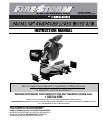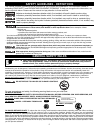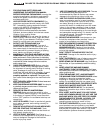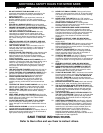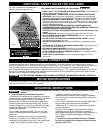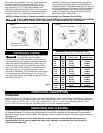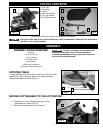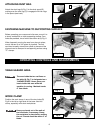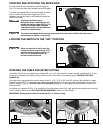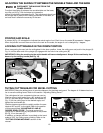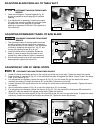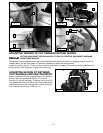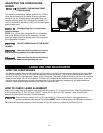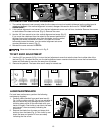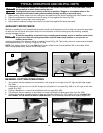
For your convenience and safety, the following warning labels are on your miter saw.
ON MOTOR HOUSING:
WARNING: FOR YOUR OWN SAFETY, READ INSTRUCTION MANUAL BEFORE OPERATING SAW. WHEN SERVICING, USE
ONLY IDENTICAL REPLACEMENT PARTS. ALWAYS WEAR EYE PROTECTION.
ON FENCE: CLAMP SMALL PIECES BEFORE CUTTING. SEE MANUAL
ON GUARD: DANGER – KEEP AWAY FROM BLADE.
ON GUARD RETAINER PLATE: To reduce the risk of injury, read instruction manual before operating miter saw. When servicing,
use only identical replacement parts. Do not expose to rain or use in damp locations. Always use proper eye and respiratory
protection. Use only 10" (254mm) saw blades recommended for 5200RPM or higher with 5/8" arbor." Keep hands out of path of saw
blade. Do not operate saw without guards in place. Check lower guard for proper closing before each use. Always tighten adjustment
knobs before use. Do not perform any operation freehand. Never reach in back of saw blade. Never cross arms in front of blade.
Turn off tool and wait for saw blade to stop before moving workpiece, changing settings or moving hands. Disconnect power before
changing blade or servicing. To reduce the risk of injury, return carriage to the full rear position after each crosscut operation. Think!
you can prevent accidents.
2
Indicates an imminently hazardous situation which, if not avoided, will result in death or serious injury.
Indicates a potentially hazardous situation which, if not avoided, could result in death or serious injury.
Indicates a potentially hazardous situation which, if not avoided, may result in minor or moderate injury.
Used without the safety alert symbol indicates potentially hazardous situation which, if not avoided, may
result in property damage.
This manual contains information that is important for you to know and understand. This information relates to
protecting YOUR SAFETY and PREVENTING EQUIPMENT PROBLEMS. To help you recognize this information, we
use the symbols below. Please read the manual and pay attention to these sections.
SAFETY GUIDELINES - DEFINITIONS
GENERAL SAFETY RULES
READ AND UNDERSTAND ALL WARNINGS AND OPERATING INSTRUCTIONS BEFORE
USING THIS EQUIPMENT. Failure to follow all instructions listed below, may result in
electric shock, fire, and/or serious personal injury or property damage.
IMPORTANT SAFETY INSTRUCTIONS
Woodworking can be dangerous if safe and proper operating procedures are not followed. As with all machinery, there are certain
hazards involved with the operation of the product. Using the machine with respect and caution will considerably lessen the
possibility of personal injury. However, if normal safety precautions are overlooked or ignored, personal injury to the operator may
result. Safety equipment such as guards, push sticks, hold-downs, featherboards, goggles, dust masks and hearing protection
can reduce your potential for injury. But even the best guard won’t make up for poor judgment, carelessness or inattention.
Always use common sense
and exercise caution in the workshop. If a procedure feels dangerous, don’t try it. Figure out an
alternative procedure that feels safer. REMEMBER: Your personal safety is your responsibility.
CLAMP SMALL PIECES
BEFORE CUTTING. SEE MANUAL.
DANGER
KEEP AWAY
FROM BLADE
ON TABLE: (2 PLACES)
Some dust created by power sanding, sawing, grinding, drilling, and other construction activities contains
chemicals known to cause cancer, birth defects or other reproductive harm. Some examples of these
chemicals are:
• lead from lead-based paints,
• crystalline silica from bricks and cement and other masonry products, and
• arsenic and chromium from chemically-treated lumber (CCA).
Your risk from these exposures varies, depending on how often you do this type of work. To reduce your exposure to these
chemicals: work in a well ventilated area, and work with approved safety equipment, such as those dust masks that are specially
designed to filter out microscopic particles.
• Avoid prolonged contact with dust from power sanding, sawing, grinding, drilling, and other construction activities. Wear protective
clothing and wash exposed areas with soap and water. Allowing dust to get into your mouth, eyes, or lay on the skin may promote
absorption of harmful chemicals.
Use of this tool can generate and/or disperse dust, which may cause serious and permanent respiratory or
other injury. Always use NIOSH/OSHA approved respiratory protection appropriate for the dust exposure. Direct
particles away from face and body.
Wear appropriate hearing protection during use. Under some conditions and duration of use, noise from this
product may contribute to hearing loss.
DO NOT EXPOSE TO RAIN OR USE IN DAMP LOCATIONS.



